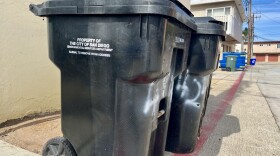San Diego County Supervisor Terra Lawson-Remer joined academic leaders and others on Monday to ask Congress to reconsider cuts to the federal National Institutes of Health.
Lawson-Remer, the acting chair of the Board of Supervisors, on Monday announced a resolution she will bring before the board on June 3 urging the federal government to reconsider a proposed 40% cut in NIH funding.
"These cuts could gut cancer research, cancel clinical trials, and push promising young scientists out of the field," she said. "San Diego leads the nation in life sciences — we've spent decades building this infrastructure. We cannot afford to recklessly dismantle it."
The cuts are part of an effort by President Donald Trump's administration to make the government more efficient, but local opponents say it will be disastrous for San Diego County's $57 billion life sciences sector. The NIH laid off hundreds of staff earlier this month.
"Cuts to NIH funding disrupt clinical trials and biomedical discoveries, stall critical scientific breakthroughs, and undermine the future scientific workforce needed to address tomorrow's most pressing challenges," said Dr. Corinne Peek-Asa, vice chancellor for research at UC San Diego. "This erosion puts America's leadership in innovation at risk — and directly impacts the health, jobs, and future treatments that San Diegans count on.
"UC San Diego joins partners across the region in urging the federal government to protect these critical investments in scientific discovery."
Beyond medical research, the funding freeze and cuts are contributing to a brain drain, she said.
"We are accepting few doctoral students as we are watching our young investigators go to industry or to other countries," Peek-Asa said. "We have a workforce that we can't build up and we have a pipeline of discoveries that we can't afford to interrupt."
Sarah van Dijk, a second-year Ph.D. student at UC San Diego, is one of those students who is considering finishing her education elsewhere. She said her future as a researcher in the U.S. is looking bleak.
“I'm actually a dual citizen of the Netherlands, so that's a place I've been potentially looking," van Dijk said. "And they've invested a lot of, funding into their research program. So it's definitely a possibility.”
In March, Dr. Jayanta Bhattacharya took over the NIH as director following Senate confirmation. He said he was seeking to tackle chronic disease in his new role.
"Chronic diseases such as cancer, heart disease, diabetes and obesity continue to cause poor health outcomes in every community across the United States," he said. "Novel biomedical discoveries that enhance health and lengthen life are more vital than ever to our country's future.
"As NIH Director, I will build on the agency's long and illustrious history of supporting breakthroughs in biology and medicine by fostering gold- standard research and innovation to address the chronic disease crisis."
Between the end of February and early April, the federal government ended around 700 NIH grants worth $1.81 billion — about 3.3% of the federal agency's annual operating budget, according to research published in the Journal of the American Medical Association.
According to Lawson-Remer's office, the proposed reduction in NIH funding "could result in over $500 million in lost economic activity and put more than 3,000 local jobs at risk across San Diego's globally recognized research and biotech ecosystem."
"The proposed cuts to NIH funding will have devastating consequences for San Diego's economy — but more importantly, for the health of our region, the nation, and the world," said Dr. Kurt Marek, chief research development officer at Sanford Burnham Prebys and a former NIH program director. "The NIH has been incredibly successful for 80 years — eradicating diseases like polio, reducing millions of deaths from cancer, and powering U.S. innovation and leadership.
"These current and proposed cuts are arbitrary and capricious, but their impacts are real — for our health and our economy."
If the cuts go through, he said it could be decades before the biomedical research enterprise in the U.S. recovers in full.
"When the grants are cut, people have to be laid off. We have to terminate postdocs, staff, scientists, technicians, graduate students who would be doing this work," Marek said. "They're going to have to go find other jobs, getting them to come back into the cancer research enterprise just isn't going to happen for a very long time.
San Diego is the third-largest recipient of NIH funding in the country, a statement from Lawson-Remer's office read.
"This fight is about protecting the medical breakthroughs our families depend on, the jobs our economy relies on, and the future that San Diego is helping to build," said Lawson-Remer. "We cannot stay quiet while NIH funding is on the chopping block — not when the cost could be measured in lives, jobs, and years of research lost."






